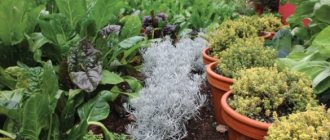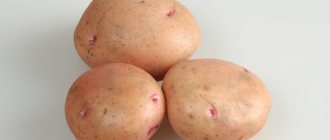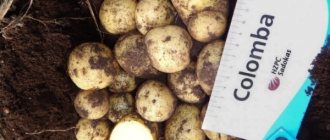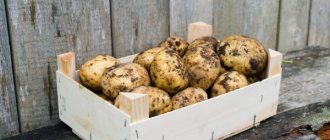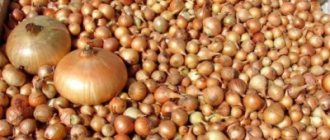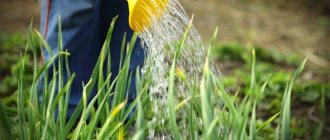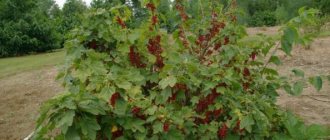Planting potatoes underground allows you to get an early harvest, because this crop ripens faster in winter-spring moisture conditions. The plant manages to produce tubers before the heat arrives and late blight appears, so there is practically no need to treat for diseases. However, there are also risks, including the possibility of seed material dying over the winter. Let’s figure out how to plant potatoes correctly in order to reap a good harvest.
Is it possible to plant before winter?
In the spring, you can often see seedlings emerging from the ground, which come from nightshade or tomato fruits that have overwintered in the soil. Potatoes are also a member of the nightshade family, so they can be planted in the fall and bear fruit in the spring. This is also supported by the fact that potatoes remaining in the ground at great depths make their way to the surface in the spring, although they form small tubers.
More skilled gardeners, on the contrary, specially plant potatoes before winter so as not to waste time in the spring. The yield of winter potatoes is no less than those planted in the spring. This requires a really snowy winter. No matter how strange it may seem, pre-winter planting of tubers is not justified in the southern and south-eastern regions, where there is little snowfall and prolonged thaws often occur in the middle of winter.
In conditions of sudden warmth, the tubers germinate, and when severe frosts occur afterwards, they die.
When planting potatoes in winter, it is worth considering the approximate time of formation of snow cover and its thickness. It protects the soil from deep freezing, so the tubers will not freeze. As a rule, this cover is formed only in December. In the southwestern territories, its height at the beginning of winter ranges from 2 to 3 cm, and at the end it reaches up to 6-7 cm. In the central and southeastern regions, the height of the cover ranges from 5-10 cm to 20-23 cm.
Care
Before the snow falls, potato beds do not need any care. In winter, especially during severe frosts, the area is covered with an additional layer of snow. In the spring, when the temperature is stable above zero degrees, the mulch is removed. After the emergence of seedlings, hilling is carried out and the weeds are weeded out. In dry weather, watering is organized.
Growing potatoes by planting them before winter is a risky undertaking, but under favorable conditions it gives an early and rich harvest.
Found a violation? Report content
Choosing a place to plant potatoes and preparing them
A suitable place for planting is one that is protected from the sun and where melt water does not stagnate. For example, this could be an area near a fence, currant bushes or gooseberries. To obtain a good harvest, it is recommended to carry out winter planting on sandy or sandy loam soils. A good harvest can also be harvested from loam. On clay lands, where water stagnates in the spring, planting should be done in beds rather than on a flat surface. This will protect the tubers from getting wet.
In areas where potatoes sprout in summer, many pests remain after harvesting, so they are not suitable for planting tubers for the winter. So, the site needs to be chosen elsewhere. It is advisable that cabbage or legumes have previously grown on it.
The selected area must be prepared in the correct way:
- Clean and process with a disc harrow using a walk-behind tractor or walk-behind tractor.
- Apply organic fertilizer. As a rule, gardeners use manure or humus.
- Leave for a while and loosen the soil. The optimal depth is up to 30 cm.
- Cultivate after rains. To do this, you will need light agricultural equipment, for example, a walk-behind tractor or a mini-tractor.
To prevent potato rotting, it is worth developing a site with a slight slope, which will ensure normal absorption and distribution of moisture in the soil.
Reviews from gardeners
Lorik 66, Korolev
I never planted it on purpose, but tubers missed during harvesting sometimes sprouted in the spring, and even the harvest was no worse than that planted in the spring, but in our climate, I think this is risky. It’s hard to guess the planting dates. If you plant, but the snow doesn’t fall and the frost hits harder, it freezes, and as a result you may be left without a harvest. But you can try it as an experiment.
Source: dacha.wcb.ru
Gardener, Ryazan region
We are near the Tambov region. In the village where I have a garden there is sand. Therefore, while there is moisture after the snow melts, the locals try to plant early. According to my observations: 1. Potatoes will not start to grow in the cold anyway. They need warming up. 2. Yes, tops appears earlier and then there are frosts. Everything freezes completely. 3. Those potatoes that were not dug up in the fall (having spent the winter in the ground) sprout, but they are much weaker than spring ones.
Source: forum.prihoz.ru
Selection of seed
Potatoes planted in the fall will have to winter in extreme conditions, and in the spring their sprouts need to wade through a thick layer of soil. In this regard, it is recommended to choose large tubers weighing at least 100-150 g for planting, and they must be completely healthy.
It is worth considering that many vegetable diseases make themselves felt only during vernalization. Since tubers for autumn planting are not vernalized, in July, when the tops are still green, it is worth marking with pegs the healthiest and most powerful bushes that are not affected by any diseases. It is the fruits of these bushes that will serve as seed material.
Of course, in addition to the correct selection of the tubers themselves, you need to pay special attention to the choice of plant variety. To do this, it is worth considering two nuances:
- To obtain an early harvest, early varieties are planted (necessarily frost-resistant), of which “Luck” is a representative, however, there is a risk that during the January thaw the tubers will go up, but a significant part of the bushes will die with the onset of frost.
Ultra-early varieties germinate too quickly in the spring, so they can freeze even at night at low air temperatures.
- Late varieties, including Lorch, Zdabytak and Asterix, are more resistant to temperature changes, but they take much longer to germinate, first growing a root system, and then powerful tops, which quickly become coarser.
So, the best option is mid-early potatoes, since they are more productive than late varieties, and also sprout later than early varieties. Here are examples of mid-early ripening potatoes:
- Nevsky;
- Svitanok Kyiv;
- Volzhanin;
- Agria;
- Adretta;
- Impala;
- Call;
- Karatop;
- Margarita;
- Horizon;
- Radich;
- Haze;
- Sturdy;
- Talovsky 110;
- Caprice;
- Aksamit;
- Lapis lazuli;
- Uladar;
- Lily;
- Breeze;
- Yavar.
For planting in the first half of winter, it is worth using unsprouted sprouts, and in the second half - sprouted ones, which in February can grow from 2 to 4 cm. In this case, the risk of frost is practically reduced to zero.
Which varieties to choose?
Experts do not recommend planting super-early and early varieties before winter, because they will sprout before frost and die in the winter. It is best to use mid-early and late ripening tubers. They germinate a little later and have higher yields. If you want to grow winter potatoes, then try planting Adretta, Volzhanin, Horizon or Udacha.
Preparing tubers for planting
As a rule, in winter, potato tubers die due to rot or soil pests that infect the plant in the fall. So, in order to get a good harvest, you need to approach the preparation of seed material with all responsibility. In general, you need to follow two simple steps:
- 14 days before planting, place the tubers in the sun so that they can turn green inside and out. It is recommended to turn them over regularly. So, landscaping is carried out. The color of potatoes changes due to the production of solanine, an organic compound that protects the crop from soil pests, including mole crickets.
- 30 minutes immediately before planting in the holes, sprinkle the tubers with a solution obtained by mixing 10 liters of water, 4 g of Aktar and 10 g of Fundazol. This will protect the plant from rotting and pests in the first stages of development in the soil.
At what depth should I plant?
The key to successful wintering of tubers is planting at the correct depth. The following points were established empirically:
- when planted to a depth of 0 to 12 cm, the tubers freeze and die;
- when planted to a depth of 20 to 30 cm, the tubers are pressed down by an excessively dense layer of soil, and their sprouts are greatly weakened when they break out.
Thus, the optimal depth is from 12 to 20 cm. In this case, one should also take into account the mass of potatoes for sowing. The sprout will be able to emerge from a depth of more than 20 cm if the tuber weighs 100 g or more.
Methods of planting potatoes and harvesting
The specific sowing method is determined by the type of soil and the location of the site. In spring, the soil in the garden bed hardens. Of course, the heavier the soil becomes, the more difficult it will be for the sprouts to break through it. If the site is located in a lowland, it may be flooded after the snow melts. Taking into account these nuances, potatoes are planted.
Light soil
Sowing is done during periods of autumn frosts, when the soil freezes slightly in the morning and thaws during the day. You must adhere to the following instructions:
- Create double beds 70cm wide using pegs and twine. The optimal distance between them is from 80 to 100 cm. These parameters should not be violated, since greenhouses will need to be installed in the spring. As for the distance between the rows, it can be from 25 to 30 cm. The planting is checkerboard.
- Dig holes 15-20 cm deep. Cover the bottom with compost, a handful of ash, and onion peels to protect the crop from wireworms. It is better to avoid pure rotted manure, as it is attractive to mole crickets. In the absence of organic matter, fertilizers can be scattered over the bed in a ratio of 30-40 g of potassium chloride and 40-60 g of superphosphate per 1 square meter. m. Afterwards you need to cover the soil with a rake.
- Sprinkle the planting material with clean water and lightly sprinkle with ground red hot pepper to protect it from mice. You can simply treat it with a 1% solution of Bordeaux mixture.
- Place the potatoes in the holes and cover with soil.
- Cover the beds with branches (preferably pine or spruce) for drainage, and cover them with a layer of organic matter made from sawdust, hay and straw. Its optimal thickness is 30-40 cm. Then place poisoned cakes around the area for rodents.
- Cover the bed with white spunbond. You will have to discard the film, since the plant will rot under it.
Read more about planting and growing potatoes under straw/hay here.
With the onset of spring, do the following:
- Remove the mulch and install arches over the beds. Pull spunbond over them.
- If the potatoes have sprouted, the soil has dried out at a depth of 7-8 cm, and the rains are not coming, it is worth watering. It is recommended to add a growth stimulator to the water, for example, Baikal EM-1.
- Remove the greenhouses when the height of the sprouts is 10-15 cm. The bushes need to be hilled.
- Harvest when the tops dry. The area must first be cleaned.
This method is used for sandy, sandy loam or loamy soils.
Clay soils
For autumn planting of potatoes, you will need a lot of hay, which is cut in several stages - in July, August and September. Planting is done as follows:
- Cover the area with hay and straw. The layer must be continuous and at least 30 cm thick.
- Divide the beds, maintaining a distance of 1 m between the rows, and 70 cm between the tubers in the row. The planting is staggered.
- Make a hole with a stake through the layer of hay. Their optimal depth is 30 cm and width is 8-10 cm.
- Separately prepare fertile soil - mix compost and ash in a ratio of 1 to 1. Pour about 1 cup of the mixture into each hole, and place a tuber on top, sprinkled with hot red pepper powder. Then throw the mixture again to a thickness of 3 cm.
- Plug the holes in the hay “cushion” with strands obtained by tightly twisting dry grass.
- In rainy weather, cover the beds with black spunbond, which must be removed with the first snow. In winter, the plant is warmed by hay, on which the lower layer of snow melts. So, a snow dome actually forms over the potatoes, which protects them from frost.
In the spring, the weeds under the mulch turn into humus under the influence of bacteria, and the potatoes sprout. It does not need to be processed or fertilized, and it is already protected from late blight thanks to the hay bacillus in the mulch. The first shoots will sprout already on the 10-14th day, and the fruits themselves can be collected on the 40th day.
It is advisable to use this method on clayey as well as on light soils when there is a threat of flooding of the beds.
Advantages and disadvantages
Winter planting of potatoes has the following advantages:
- you can get an early harvest, since seedlings appear 1.5-2 weeks earlier than with spring sowing;
- on “winter” potatoes, the most productive sprouts remain intact, which often break off in the fruits of spring planting;
- no cellar is needed to store planting material;
- planting work can not be carried out in a hurry, and there is no need to water the furrows or fight weeds;
- the plant is resistant to late blight, especially since Colorado potato beetles rarely eat tough greens, preferring young leaves of spring planting;
- Fruits from winter planting do not need to be hilled.
Despite all the above advantages, it is worth taking into account quite significant disadvantages:
- even central Russia is exposed to serious frosts below 15 degrees, and for potatoes, a drop in temperature below -10...-12 degrees is a serious risk of freezing;
- in the case of an excessively rainy spring or a very snowy winter, the tubers may become wet, so the seedlings will be excessively sparse;
- it is difficult to protect the crop from blackleg, wireworm and the same Colorado potato beetle, since infection appears only during the germination of tubers, and during winter planting it is not possible to remove the infected material in a timely manner;
- Often such planting is unsuitable for use on clayey and medium-clayey soils, which are prone to severe compaction - it is difficult for sprouts to break through the surface, they are often affected by rhizoctonia, and the number of stems and, accordingly, the overall yield of the bush are reduced.
Advantages and disadvantages
The advantages of this method include:
- early ripening of young tubers;
- high yield rates;
- full use of spring moisture;
- absence of late blight.
Planting before winter also has many disadvantages. These include:
- there is a high risk of death of seed tubers during severe frosts and little snow in the winter;
- stagnation of melt water leads to loss of germination of planting material;
- high consumption of tubers;
- vulnerability to rodents during the hungry period;
- the method is completely unsuitable for the northern regions.
Experienced gardeners plant only a small part of the planting material before winter, because there is a high risk of being left without potatoes.
